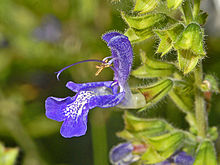Salvia transsylvanica
| Salvia transsylvanica | |
|---|---|

| |
| Flower of Salvia transsylvanica at the Orto Botanico di Brera | |
| Scientific classification | |
| Kingdom: | Plantae |
| Clade: | Tracheophytes |
| Clade: | Angiosperms |
| Clade: | Eudicots |
| Clade: | Asterids |
| Order: | Lamiales |
| Family: | Lamiaceae |
| Genus: | Salvia |
| Species: | S. transsylvanica
|
| Binomial name | |
| Salvia transsylvanica | |
| Synonyms[1] | |
| |
Salvia transsylvanica is a species of flowering plant in the family Lamiaceae.[1][2] It is a herbaceous perennial native to a wide area from north and central Russia to Romania. It was described and named in 1853 by botanist Philipp Johann Ferdinand Schur, with the specific epithet referring to the Transylvanian Alps located in central Romania. It was introduced into horticulture in the 1980s.[3]
Salvia transsylvanica puts out several lax 2 feet (0.61 m) stems from a basal clump of leaves. The leaves that grow on the stem vary in size—being larger at the bottom—with the upper side being dark yellow-green and the underside pale with yellow veins. The leaves are very scalloped around the edges. The flowers are slightly longer than 0.5 inches (1.3 cm), and have a rich violet color, growing in loose whorls that are about .5 inches (1.3 cm) apart. Many flowers bloom at once, giving the plant a very colorful and striking appearance.[3]
Notes[edit]
- ^ a b "Salvia transsylvanica (Schur ex Griseb. & Schenk) Schur". Plants of the World Online. The Trustees of the Royal Botanic Gardens, Kew. n.d. Retrieved May 18, 2024.
- ^ "Salvia transsylvanica (Schur ex Griseb. & Schenk) Schur". Catalogue of Life. Species 2000. n.d. Retrieved May 18, 2024.
- ^ a b Clebsch, Betsy; Barner, Carol D. (2003). The New Book of Salvias. Timber Press. p. 290. ISBN 978-0-88192-560-9.
